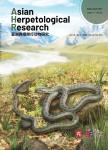Embryonic Growth and Yolk Depletion during Incubation in the Chinese Skink, Plestiodon chinensis
Embryonic Growth and Yolk Depletion during Incubation in the Chinese Skink, Plestiodon chinensis作者机构:Jiangsu Key Laboratory for Biodiversity and Biotechnology College of Life Sciences Nanjing Normal University
出 版 物:《Asian Herpetological Research》 (亚洲两栖爬行动物研究(英文版))
年 卷 期:2019年第10卷第1期
页 面:56-61页
核心收录:
学科分类:0710[理学-生物学] 0905[农学-畜牧学] 09[农学] 0906[农学-兽医学] 090501[农学-动物遗传育种与繁殖]
基 金:National Natural Science Foundation of China (31470471)
主 题:egg incubation embryonic growth embryonic stage Plestiodon chinensis scincid lizard yolk depletion
摘 要:We collected 24 gravid female Chinese skinks(Plestiodon chinensis) to study embryonic growth and yolk depletion during incubation. Females laid eggs between late May and mid-June. Eggs were incubated at 24(± 0.3) ℃. One egg from each clutch was dissected at 5-d intervals starting at laying. Embryonic stages at laying varied from Dufaure and Hubert s(1961) Stage 30-35, with a mean stage of 32.6. Incubation lengths at 24 ℃ varied from 35.1 to 48.3 d, with a mean of 41.5 d. Based on the derived functions describing instantaneous changes in embryo dry mass and yolk dry mass, we identified three phases of embryonic growth or yolk depletion in P. chinensis. Phase 1, from Day 0(at laying) to Day 15(~36% of the way through incubation), was one of minimal transfer of material from yolk to embryo. Phase 2, from Day 15 to Day 32-33(~77%-80% of the way through incubation), was characterized by increasingly rapid embryonic growth or yolk depletion. Phase 3, from Day 32-33 to hatching, was characterized by reduced embryonic growth or yolk depletion. The length of the last embryonic stage(Stage 40 = completely differentiated embryos) accounted for about 28% of incubation length, and the dry mass of the smallest embryos of Stage 40 accounted for only ~48% of the hatchling dry mass. Our study adds evidence to the idea that oviposition is not timed to coincide with the onset of rapid embryonic growth in oviparous reptiles, and is first to demonstrate that ~50% embryonic growth occurs in the last quarter of incubation in P. chinensis.



